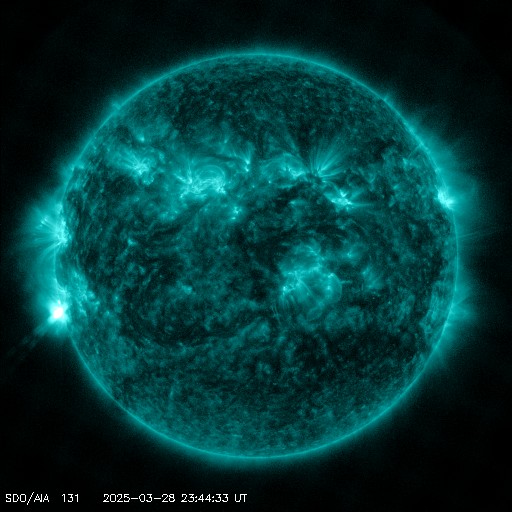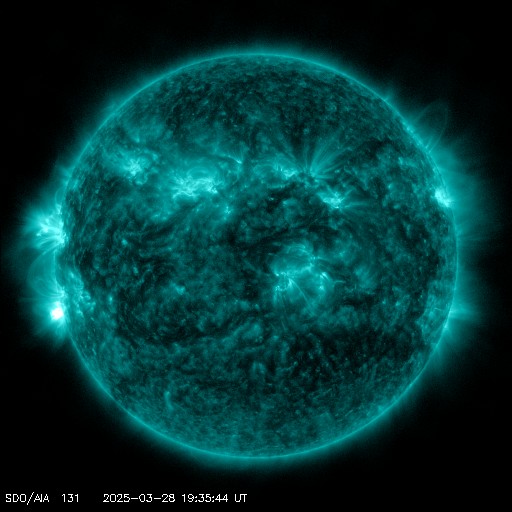Viewing archive of Monday, 13 June 2011
Solar activity report
Any mentioned solar flare in this report has a scaling factor applied by the Space Weather Prediction Center (SWPC). Because of the SWPC scaling factor, solar flares are reported as 42% smaller than for the science quality data. The scaling factor has been removed from our archived solar flare data to reflect the true physical units.
Report of Solar-Geophysical Activity 2011 Jun 13 2200 UTCPrepared by the NOAA © SWPC and processed by SpaceWeatherLive.com
Joint USAF/NOAA Report of Solar and Geophysical Activity
SDF Number 164 Issued at 2200Z on 13 Jun 2011IA. Analysis of Solar Active Regions and Activity from 12-2100Z to 13-2100Z
Solar activity was at low levels. A C1 x-ray event was
observed at 13/0055Z from an area of enhanced brightening on the
east limb near N20. Region 1234 (S16E07) remained the only spotted
region on the disk. The region produced a few B-class events, the
largest a B9 x-ray event at 13/0616Z. Region 1234 indicated little
change over the past 24 hours and remained a simple B-type, bi-polar
group. A partial halo CME was observed lifting off the SE limb,
first observed in C2 SOHO LASCO imagery at 13/0424Z, and later in C3
imagery at 13/0454Z. The plane-of-sky velocity was estimated at near
600 km/s. The CME appeared to originate from a bright area of plage
centered near old Region 1223 (S17, L=125), first viewed in STEREO-B
EUVI imagery at 13/0355Z as an area of northward surging.
IB. Solar Activity Forecast
Solar activity is expected to be very
low for the next three days (14 - 16 June) with a chance for an
isolated C-class flare.
IIA. Geophysical Activity Summary 12-2100Z to 13-2100Z
The geomagnetic field was at quiet to unsettled levels. ACE solar
wind data indicated the continued presence of a coronal hole high
speed stream (CH HSS) with wind speeds averaging about 450 km/s. The
greater than 10 MeV proton flux at geosynchronous orbit remained
enhanced with a maximum flux reading of 4.8 pfu at 13/1010Z.
IIB. Geophysical Activity Forecast
The geomagnetic field is
expected to be at quiet to unsettled levels for day one (14 June)
with a chance for active levels due to continued CH HSS effects.
Activity is expected to decrease to quiet levels on days two and
three (15 - 16 June) as the CH HSS subsides. The greater than 10 MeV
protons are expected to remain enhanced through 14 June, returning
to background levels by 15 June.
III. Event Probabilities 14 Jun to 16 Jun
| Class M | 01% | 01% | 01% |
| Class X | 01% | 01% | 01% |
| Proton | 10% | 01% | 01% |
| PCAF | green | ||
IV. Penticton 10.7 cm Flux
Observed 13 Jun 087 Predicted 14 Jun-16 Jun 089/091/093 90 Day Mean 13 Jun 103
V. Geomagnetic A Indices
Observed Afr/Ap 12 Jun 005/009 Estimated Afr/Ap 13 Jun 008/008 Predicted Afr/Ap 14 Jun-16 Jun 008/008-005/005-005/005
VI. Geomagnetic Activity Probabilities 14 Jun to 16 Jun
| A. Middle Latitudes | |||
|---|---|---|---|
| Active | 15% | 05% | 05% |
| Minor storm | 05% | 01% | 01% |
| Major-severe storm | 01% | 01% | 01% |
| B. High Latitudes | |||
|---|---|---|---|
| Active | 20% | 10% | 05% |
| Minor storm | 10% | 01% | 01% |
| Major-severe storm | 01% | 01% | 01% |
All times in UTC
Current data suggests there is a slight possibility for aurora to appear at the following high latitude regions in the near future
Norilsk, VorkutaLatest news
Latest forum messages
AR4046 127Incoming & Unnumbered Active Regions 1657Aurora photography hints for those of us with smartphones 48Large Coronal Hole 25 178LASCO Data Not Updating 5
More topicsSupport SpaceWeatherLive.com!
A lot of people come to SpaceWeatherLive to follow the Sun's activity or if there is aurora to be seen, but with more traffic comes higher server costs. Consider a donation if you enjoy SpaceWeatherLive so we can keep the website online!

Latest alerts
00:00 UTC - Solar flare
Moderate M1.79 flare
Friday, 28 March 2025
23:36 UTC - Radio Blackout
Minor R1 radio blackout in progress (≥M1 - current: M1.04)
21:24 UTC - Hemispheric Power Index
The OVATION model predicts the Hemispheric Power Index to reach 51GW at 21:59 UTC
19:45 UTC - Solar flare
Moderate M1.16 flare
19:27 UTC - Radio Blackout
Minor R1 radio blackout in progress (≥M1 - current: M1.1)
Space weather facts
| Last X-flare | 2025/03/28 | X1.1 |
| Last M-flare | 2025/03/28 | M1.7 |
| Last geomagnetic storm | 2025/03/27 | Kp5 (G1) |
| Spotless days | |
|---|---|
| Last spotless day | 2022/06/08 |
| Monthly mean Sunspot Number | |
|---|---|
| February 2025 | 154.6 +17.6 |
| March 2025 | 128.3 -26.4 |
| Last 30 days | 128.3 -23.7 |




